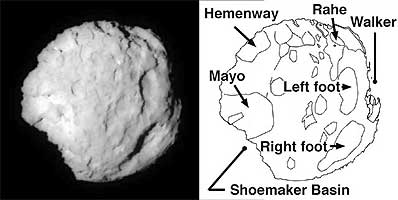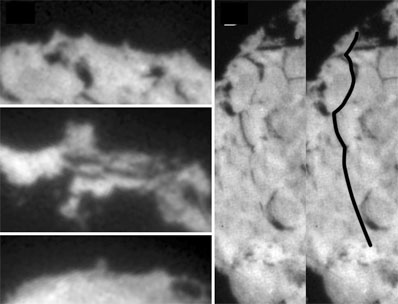
Spaceflight Now +

|

|

|

|

Premium video content for our Spaceflight Now Plus subscribers.

Stardust briefing
 Scientist present new findings from the Stardust spacecraft's encounter with Comet Wild 2 in this news conference from NASA Headquarters on June 17. (26min 12sec file) Scientist present new findings from the Stardust spacecraft's encounter with Comet Wild 2 in this news conference from NASA Headquarters on June 17. (26min 12sec file)
 Play video Play video

New pictures explained
 New pictures of Comet Wild 2 from NASA's Stardust spacecraft are shown here with narration by lead mission scientist Donald Brownlee. (3min 06sec file) New pictures of Comet Wild 2 from NASA's Stardust spacecraft are shown here with narration by lead mission scientist Donald Brownlee. (3min 06sec file)
 Play video Play video

Stardust's comet flyby
 Animation depicting Stardust's flyby of Comet Wild 2 and the powerful jets of dust streaming from the comet's surface is presented with narration by scientist Benton Clark. (1min 59sec file) Animation depicting Stardust's flyby of Comet Wild 2 and the powerful jets of dust streaming from the comet's surface is presented with narration by scientist Benton Clark. (1min 59sec file)
 Play video Play video

Moon-Mars commission
 After releasing its report, the President's Commission on Moon, Mars and Beyond holds a news conference in Washington. (60min 18sec file) After releasing its report, the President's Commission on Moon, Mars and Beyond holds a news conference in Washington. (60min 18sec file)
 Play video Play video

NASA workers respond
 NASA Administrator Sean O'Keefe and commission chairman Pete Aldridge address the NASA workforce and answer questions after the Moon, Mars and Beyond report is released. (75min 24sec file) NASA Administrator Sean O'Keefe and commission chairman Pete Aldridge address the NASA workforce and answer questions after the Moon, Mars and Beyond report is released. (75min 24sec file)
 Play video Play video

Tuesday's Mars briefing
 Mars rover Spirit's arrival at the Columbia Hills, trouble with one of its wheels and Opportunity's descent into Endurance Crater and all of the latest pictures are presented at this briefing from June 15. (30min 27sec file) Mars rover Spirit's arrival at the Columbia Hills, trouble with one of its wheels and Opportunity's descent into Endurance Crater and all of the latest pictures are presented at this briefing from June 15. (30min 27sec file)
 Play video Play video

Ride with Opportunity
 Cameras on Opportunity provides this "ride-along" view of the rover's risky drive into Endurance Crater. Expert narration by science team member Scott McLennan. (30sec file) Cameras on Opportunity provides this "ride-along" view of the rover's risky drive into Endurance Crater. Expert narration by science team member Scott McLennan. (30sec file)
 Play video Play video

Opportunity panorama
 Another stunning color panorama from the Mars rover Opportunity looking into Endurance Crater and the surrounding plains is presented with expert narration by science team member Scott McLennan. (1min 30sec file) Another stunning color panorama from the Mars rover Opportunity looking into Endurance Crater and the surrounding plains is presented with expert narration by science team member Scott McLennan. (1min 30sec file)
 Play video Play video

Spirit panorama
 Spirit has generated this panorama from the base of the Columbia Hills. Expert narration is provided by science team member Larry Soderblom. (1min 15sec file) Spirit has generated this panorama from the base of the Columbia Hills. Expert narration is provided by science team member Larry Soderblom. (1min 15sec file)
 Play video Play video

New Spirit pictures
 New pictures from Mars rover Spirit showing the "Pot of Gold" rock area and other features are revealed with expert narration by science team member Larry Soderblom. (4min 47sec file) New pictures from Mars rover Spirit showing the "Pot of Gold" rock area and other features are revealed with expert narration by science team member Larry Soderblom. (4min 47sec file)
 Play video Play video

 Become a subscriber Become a subscriber
 More video More video

|

|

|

|

|

|

Stardust reveals surprising anatomy of a comet
NASA/JPL NEWS RELEASE
Posted: June 17, 2004
Findings from a historic encounter between NASA's Stardust spacecraft and a comet have revealed a much stranger world than previously believed. The comet's rigid surface, dotted with towering pinnacles, plunging craters, steep cliffs, and dozens of jets spewing violently, has surprised scientists.

This image shows the comet Wild 2, which NASA's Stardust spacecraft flew by on Jan. 2, 2004. This image is the closest short exposure of the comet. The listed names on the diagram are those used by the Stardust team to identify features. "Basin" does not imply an impact origin. Credit: NASA/JPL-Caltech
|
"We thought Comet Wild 2 would be like a dirty, black, fluffy snowball," said Stardust Principal Investigator Dr. Donald Brownlee of the University of Washington, Seattle. "Instead, it was mind-boggling to see the diverse landscape in the first pictures from Stardust, including spires, pits and craters, which must be supported by a cohesive surface."
Stardust gathered the images on Jan. 2, 2004, when it flew 236 kilometers (about 147 miles) from Wild 2. The flyby yielded the most detailed, high-resolution comet images ever.
"We know Wild 2 has features sculpted by many processes. It may turn out to be typical of other comets, but it is unlike any other type of solar system body," Brownlee said. He is lead author of one of four Stardust papers appearing in the Fri., June 18, issue of Science. "We're fortunate that nature gave us such a rich object to study."
Stardust images show pinnacles 100 meters tall (328 feet), and craters more than 150 meters deep (492 feet). Some craters have a round central pit surrounded by ragged, ejected material, while others have a flat floor and straight sides. The diameter of one large crater, called Left Foot, is one fifth of the surface of the comet. Left Foot is one kilometer (.62 miles) across, while the entire comet is only five kilometers (3.1 miles) across.

These images taken by NASA's Stardust spacecraft highlight the diverse features that make up the surface of comet Wild 2. Side A shows a variety of small pinnacles and mesas seen on the limb of the comet. Side B hows the location of a 2-kilometer (1.2-mile) series of aligned scarps, or cliffs. Credit: NASA/JPL-Caltech
Download larger image here
|
"Another big surprise was the abundance and behavior of jets of particles shooting up from the comet's surface. We expected a couple of jets, but saw more than two dozen in the brief flyby," said Dr. Benton Clark, chief scientist of space exploration systems, Lockheed Martin Space Systems, Denver.
The team predicted the jets would shoot up for a short distance, and then be dispersed into a halo around Wild 2. Instead, some super-speedy jets remained intact, like blasts of water from a powerful garden hose. This phenomenon created quite a wild ride for Stardust during the encounter.
"Stardust was absolutely pummeled. It flew through three huge jets that bombarded the spacecraft with about a million particles per second," said Thomas Duxbury, Stardust project manager at NASA's Jet Propulsion Laboratory, Pasadena, Calif. Twelve particles, some larger than a bullet, penetrated the top layer of the spacecraft's protective shield.
The violent jets may form when the Sun shines on icy areas near or just below the comet's surface. The solid ice becomes a gas without going through a liquid phase. Escaping into the vacuum of space, the jets blast out at hundreds of kilometers per hour.
The Stardust team theorizes sublimation and object hits may have created the comet's distinct features. Some features may have formed billions of years ago, when life began on Earth, Brownlee said. Particles collected by Stardust during the Wild 2 encounter may help unscramble the secrets of how the solar system formed.
Stardust was launched in 1999. It is zooming back to Earth with thousands of captured particles tucked inside a capsule. The capsule will make a soft landing in the Utah desert in January 2006. The samples will be analyzed at the planetary material curatorial facility at NASA's Johnson Space Center, Houston.
Comets have been objects of fascination through the ages. Many scientists believe they delivered carbon and water, life's building blocks, to Earth. Yet their destructive potential is illustrated by the widely held theory that a comet or asteroid wiped out the dinosaurs.

Additional coverage for subscribers:
 VIDEO:
NEW FINDINGS FROM STARDUST MISSION ANNNOUNCED QT VIDEO:
NEW FINDINGS FROM STARDUST MISSION ANNNOUNCED QT
 VIDEO:
STARDUST'S PICTURES OF COMET WITH NARRATION QT VIDEO:
STARDUST'S PICTURES OF COMET WITH NARRATION QT
 VIDEO:
NARRATED ANIMATION SHOWS COMET ENCOUNTER QT VIDEO:
NARRATED ANIMATION SHOWS COMET ENCOUNTER QT
 SUBSCRIBE NOW SUBSCRIBE NOW

|

|

|

|

|



